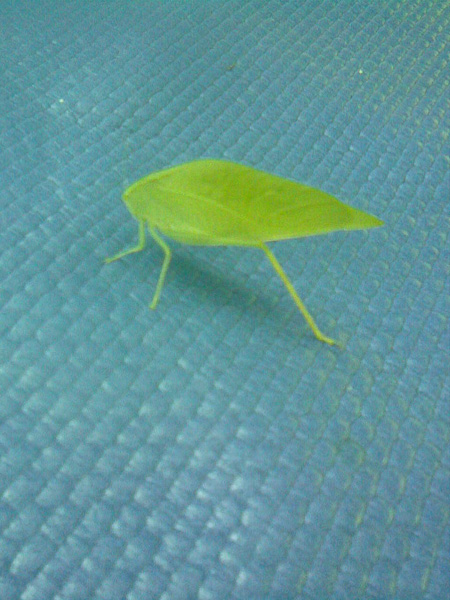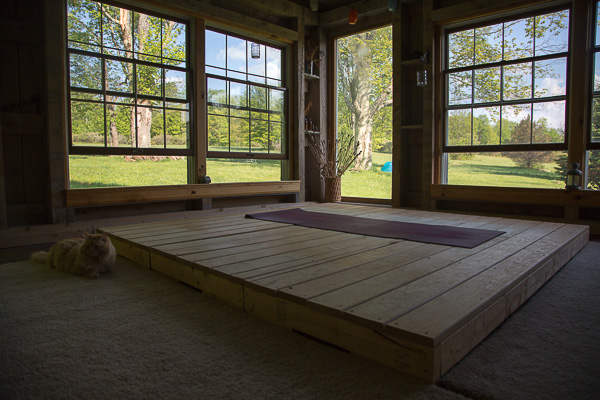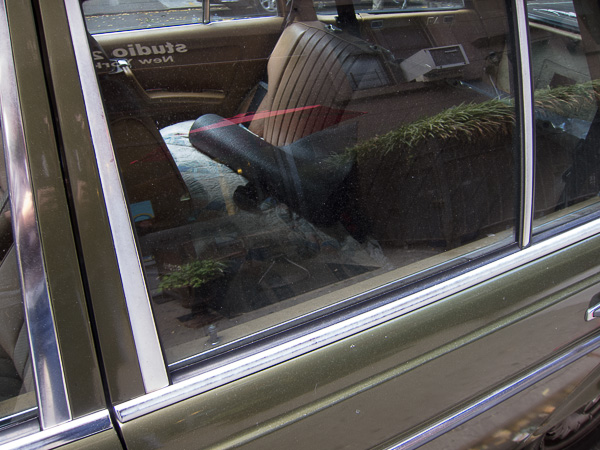yoga mats: the good, the bad, and the crumbly

The yoga mat. It is very good to have your own if you practice yoga regularly. You can contract some pretty gross stuff from communal mats. What kind of mat you want will largely depend on your yoga. If you practice a few times a week and don’t mind PVCs, a cheap mat from Gaiam or anywhere will do the trick. Expect it to be slippery until you break it in. My teacher recently gave me the best advice ever on breaking in a mat: “Don’t cut your toenails for awhile. Then they’ll chip into the mat and it will have more traction.” Amazing. I usually just tell people to machine wash it and air dry. This is an upside to the cheap mats—but don’t try it with a fancy mat. Anything but the cheap, common mat will probably not survive a machine wash.
If you practice more seriously, or don’t want a PVC mat, there are better, but more expensive options. If you practice ashtanga, you will shred a cheap mat in a week, and the little mat bubbles will stick all over you. There are two solutions to this. The first is a towel (or mysore rug), most popular in Ashtanga and Bikram, which heavy sweaters will need anyway. You use the mat for standing poses, then unfurl the towel over it for the rest. I really don’t know one brand from another, as I don’t sweat that much and don’t use one. The next solution is a good mat. Ashtangis pretty much swear by Manduka because they don’t shred, and their PRO mats are guaranteed for life. Take note: the Manduka eKO® collection are not. I bought one, expecting it to preform like my PROlite. Instead it shredded in just a few uses. It was also much more grippy—too grippy for my taste.

It took me no less than 25 emails with their customer service to convince them that a $76 yoga mat should not shred after a few uses, even if it was natural tree rubber. They finally sent me a PROLite to replace it for a $12 shipping fee. Their rep was helpful, if a times a bit absurd, suggesting that a wipe down with apple cider vinegar would stop the shredding and offering to send a “slightly used mat” to replace it (see “gross stuff” above). This was, I acknowledge, after they ran out of the sale mats they’d originally offered because Hurricane Sandy delayed my reply. I am sure they found me equally absurd.
So, yes, I recommend the PRO/PROlite mats. The PROs are extremely cushy and durable, but heavy. Not for walking about town, but great for home, studio, or I suppose, people with cars. They are cushier than the PROlite, which I’ve read some people find hard. I don’t. I also don’t find them slippery, after a break in. I heard a teacher explain that mats are slippery when dry, but stick when you’re sweaty.
I don’t find that to be the case, but maybe for some. While they are expensive, they last forever. They are made of “an eco-certified PVC material and manufactured emissions free” (their site). It’s quite awesome to have a mat you’ve spent thousands of hours on. If you get a cheaper mat and have to buy a new one every week, month, or year, that’s much more expensive than getting a good one to begin with, and harder on the planet. While I don’t adore my manduka mat, I can’t really imagine getting that excited about a mat. It’s a good mat, and it doesn’t fall apart or shed into my hair or clothes. I got mine on sale at Gilt, so they were more like $55 than $85.
 Another recommended mat, less expensive but less durable, is the eco-friendly Jade Yoga Mat. They have more traction than Manduka PROs and are made of PVC-free biodegradable tree rubber. I have a few students who like them, but I’m not sure how they’d hold up to an ashtanga practice. I see them shred within a year. They are super-grippy and you can catch on it if your jump-throughs don’t clear. Judging from web reviews, they are popular with vinyasa practitioners. I recommend them for people concerned about slippage who are not ashtangis. I’m also told this hugger mugger is cheap, not-slippery, and good.
Another recommended mat, less expensive but less durable, is the eco-friendly Jade Yoga Mat. They have more traction than Manduka PROs and are made of PVC-free biodegradable tree rubber. I have a few students who like them, but I’m not sure how they’d hold up to an ashtanga practice. I see them shred within a year. They are super-grippy and you can catch on it if your jump-throughs don’t clear. Judging from web reviews, they are popular with vinyasa practitioners. I recommend them for people concerned about slippage who are not ashtangis. I’m also told this hugger mugger is cheap, not-slippery, and good.
Mats to avoid? Anything made out of jute (a word that comes from Bangla: “name of a plant fiber used in making coarse fabrics and paper, and the plant which produces it, 1746, from Bengali jhuto, ultimately from Sanskrit juta-s “twisted hair, matted hair”*) I got one on amazon years ago and it was a disaster from the get go, shedding its juteness all over me, the studio, and the practitioners after me. It is also hard and sand papery, and literally cut my feet open. There are blood stains on that mat. I’ve had similar issues with the super-thin travel mats, made by assorted companies. They are way too thin to practice on unless you’re on carpet or grass, and that’s not ideal anyway. I suppose better than nothing, and I still travel with mine, had for $12 on amazon. Buy a cheap one though, because the pricey travel mats are no better.

Hi Anastasia,
I got myself a Manduka ProLite as well two months ago, but unfortunately, I find it really too slippery. I scrubbed it with sea salt twice and brushed it using slightly soapy water and then dried it with a towel. It’s just a bit less slippery now. One of my teachers told me that it would take at least one year to wear off the slippery surface!!! How long did it take for you? Do you have any tricks to share? Thanks in advance!
Hi Gaby,
Other than the mentioned toe nail solution, I don’t. I do find my newer prolite a bit slippery if I sweat, but I don’t sweat much, only in crowded (warmer) led classes. If you practice 6 days a week and it’s still really slippery, I’d get a mysore rug. I can’t imagine it would take a whole year to break in. My older one took a month of daily practice at most. Manduka says apple cider vinegar is best for cleaning, though who knows if it makes it less slippery. My newer prolite also has a different texture to it than my old one did, but maybe I’ve forgotten.
Good luck with it!
So I got myself the Manduka Prolite and took it straight from the package to my hot yoga class. I barely could stand on it, it was super slippery and almost fell face down several times. So dissapointed sooo.. I did some research about the break in of the Manduka mats, I only practice yoga three times a week so it will take a long time to break the mat, I needed something fast and efficient. Got myself a bottle of kosher salt and a spray bottle with a mix of 1/2 vinegar and 1/2 water and scrub the life out of my mat with a scotch brite sponge.
I scrub, left the salt overnight and the day after did the same thing scrub scrub and rinse with warm/hot water.
The difference was night and day, I will probably do it one more time after the mat is sitting on the sun and I think it will be perfect after that.
I guess I have sweaty palms and feet that doesn’t help the cause but I am positive I will make my mat work. It doesn’t slide on the wood floor and it has the perfect support for my bad knees. I hope this help others battling with a new Manduka Prolite Mat.
Adri,
Thanks for this. I wrote this years ago, and since Manduka has changed their surface. I still recommend the mat, but there seems to be a lot of variability in slipperiness. I have students who get mats that aren’t slippery, and some that are until broken in. I have one that is slippery probably 100 uses in, but I think I got thick hand lotion on it.
It is true that sweat changes slippage. I’ve heard that the basic cheap yoga mat is meant to be not slippery when wet but tends to be when dry. While I’m not sure that’s true, mats do work differently, and I think some are designed slip less if you are sweaty, which is great if you sweat, and not if you don’t.
Good work with the salt, and thanks for posting this. Having a non-slippery mat is crucial to enjoying one’s practice.
Best,
Anastasia